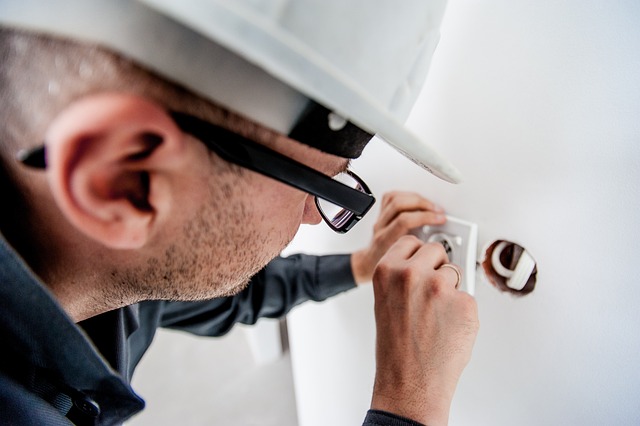Regular maintenance of your home's electrical system by a professional electrician is non-negotiable for both safety and functionality. This includes inspecting switches, receptacles, and outlets for signs of wear or damage such as discoloration or warmth. Homeowners should be vigilant about addressing any issues like overheating, loose plugs, tripped breakers, or flickering lights promptly to prevent potential electrical hazards. It's important to note that switches and receptacles have a limited lifespan; for instance, receptacles need to function properly after at least 100 insertion/removal cycles. If your home has outlets older than 40 years, they might not comply with current safety standards and may require an upgrade. An electrician can assess the entire electrical system to ensure it adheres to safety regulations and operates efficiently. They are essential for determining whether a repair or an upgrade is necessary, considering factors like the system's age, repair history, and compliance with modern safety standards. Professional electricians provide critical insights into the longevity of your system, ensuring it meets safety requirements and performs reliably over time. Regular consultations with a licensed electrician can help catch issues early, reducing the risk of more severe problems and costly repairs later on.
When household electricity flows through switches, receptacles, and outlets, safety and functionality are paramount. This article serves as a comprehensive guide for homeowners navigating the decisions of repairing or replacing these components. Understanding when professional electrician intervention is necessary can prevent potential hazards. We’ll delve into assessing your electrical system’s condition and provide expert tips to maintain it effectively, ensuring your home’s energy flows safely and efficiently.
- Assessing the Condition of Your Switches, Receptacles, and Outlets: A Homeowner's Guide to Electrical Safety
- When to Repair or Replace: Professional Electrician Tips for Maintaining Your Electrical System
Assessing the Condition of Your Switches, Receptacles, and Outlets: A Homeowner's Guide to Electrical Safety

When it comes to maintaining a safe and functional home electrical system, assessing the condition of your switches, receptacles, and outlets is paramount. Homeowners should regularly inspect these components for signs of wear or damage. If you notice any discoloration, char marks, or if an outlet feels warm to the touch, it’s time to consult a professional electrician. These could be indicators of overheating or faulty wiring, which can pose significant risks. Loose-fitting plugs in receptacles, repeated tripping of circuit breakers, or lights that flicker without cause are also symptoms that warrant immediate attention from a qualified electrician. They can determine whether a simple repair will suffice or if a replacement is necessary to maintain the integrity and safety of your home’s electrical system.
Moreover, when considering the lifespan of these components, it’s essential to understand that switches and receptacles typically have a serviceable lifespan. Receptacles, for instance, should be able to withstand a minimum of 100 insertion/removal cycles without failing to operate properly. Outlets in high-use areas or those over 40 years old may require an upgrade to meet modern electrical demands and safety standards. An electrician can provide expert guidance on the best course of action, ensuring that your home’s electrical system is up to code, efficient, and safe for you and your family. Regular maintenance and timely repairs or replacements by a certified electrician are crucial steps in safeguarding your home against potential electrical hazards.
When to Repair or Replace: Professional Electrician Tips for Maintaining Your Electrical System

When an issue arises with switches, receptacles, or outlets in your home or business, determining whether to repair or replace them is a decision best made with the guidance of a professional electrician. Factors such as the age and condition of the electrical system, the frequency of repairs, and the presence of modern safety standards all play a role in this decision. An experienced electrician will assess the extent of damage or wear and evaluate whether a simple fix will suffice or if an upgrade to newer models is necessary for optimal functionality and safety. For instance, if a receptacle frequently malfunctions after repairs, it may be time to replace it with one that offers better performance and adheres to updated electrical codes. Similarly, switches showing signs of aging or inconsistent operation could indicate the need for replacement rather than repetitive patchwork. A professional electrician can provide valuable insights into the longevity and efficiency of your electrical system, ensuring that all components not only work reliably but also comply with current safety regulations. Regular maintenance checks by a licensed electrician are crucial in identifying potential issues before they escalate into costly repairs or hazardous situations. Their expertise is instrumental in maintaining an electrical system that is both safe and functional for years to come.
When addressing the condition of your home’s switches, receptacles, and outlets, safety and functionality are paramount. Homeowners should regularly assess these components, as minor issues can escalate into significant hazards without proper attention. If you encounter faulty or damaged electrical elements, it’s advisable to consult a professional electrician who can determine whether repair or replacement is the best course of action. By adhering to expert tips for maintaining your electrical system, you ensure the safety and efficiency of your home’s power infrastructure. Always prioritize the expertise of a licensed electrician when dealing with such matters to maintain your residence’s optimal operation and protect against potential risks.
